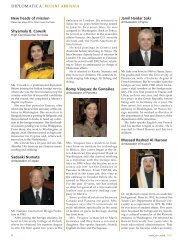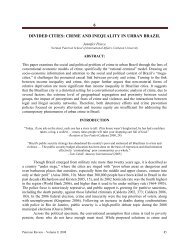the new petro power paradigm - Diplomat Magazine
the new petro power paradigm - Diplomat Magazine
the new petro power paradigm - Diplomat Magazine
You also want an ePaper? Increase the reach of your titles
YUMPU automatically turns print PDFs into web optimized ePapers that Google loves.
DELIGHTS|canadiana<br />
Sir Isaac Brock, “saviour of Upper Canada”<br />
Library and Archives Canada<br />
Tecumseh, an ally of Brock’s<br />
had established defensive measures long<br />
before war was declared, and had wisely<br />
made allies among <strong>the</strong> First Nations, including<br />
Tecumseh. With only 1,600 regulars<br />
available, Brock believed that <strong>the</strong> best<br />
defence was a strong offence that would<br />
incite <strong>the</strong> population, including <strong>the</strong> First<br />
Nations. He acted boldly, handily taking<br />
<strong>the</strong> American fort at Michilimackinac Island<br />
in Lake Huron on July 17.<br />
In August, against <strong>the</strong> counsel of his<br />
advisers, Brock advanced on Major General<br />
William Hull’s troops at Detroit,<br />
preceded by Tecumseh and his warriors<br />
who had established <strong>the</strong>mselves in <strong>the</strong> forest<br />
north of <strong>the</strong> town. Hull had no way of<br />
knowing how many warriors <strong>the</strong>re were,<br />
but he feared <strong>the</strong>m and thought <strong>the</strong>re may<br />
be thousands. There is no real evidence to<br />
support <strong>the</strong> popular story that Tecumseh<br />
marched his men three times through a<br />
forest clearing to give <strong>the</strong> impression of a<br />
larger force. British ships shelled <strong>the</strong> fort<br />
with no real physical impact and Hull surrendered<br />
to Brock without firing a shot.<br />
It was a great victory, and one that many<br />
considered <strong>the</strong> saving of Upper Canada.<br />
At Queenston Heights, (Niagara-on<strong>the</strong>-Lake),<br />
although it resulted in ano<strong>the</strong>r<br />
British victory, Brock’s audacious decision<br />
to launch a direct attack on <strong>the</strong> Americans<br />
without waiting for reinforcement proved<br />
rash. As he led his troops, he was shot in<br />
<strong>the</strong> chest and died instantly. Contrary to<br />
myth, Brock did not say “Push on brave<br />
York Volunteers.”<br />
Brock’s loss was devastating, but <strong>the</strong><br />
British did “push on” as <strong>the</strong> American<br />
campaign of 1813 focused on cutting <strong>the</strong><br />
link between Upper and Lower Canada.<br />
Ra<strong>the</strong>r than taking Kingston, <strong>the</strong> logical<br />
choice, <strong>the</strong> Americans turned to York (Toronto),<br />
a lesser prize, briefly occupying it<br />
in May and burning <strong>the</strong> public buildings<br />
as <strong>the</strong>y left town. Setting a place ablaze<br />
was sure to frustrate <strong>the</strong> enemy and both<br />
sides used <strong>the</strong> tactic, partly as strategy but<br />
largely as retaliation, as it turned out. The<br />
retaliatory burning culminated in British<br />
troops burning <strong>the</strong> White House in August<br />
1814.<br />
In May 1813, a large American army<br />
captured Fort George (Niagara-on-<strong>the</strong>-<br />
Lake) and in June <strong>the</strong> British won <strong>the</strong><br />
Battle of Stoney Creek. Shortly afterward,<br />
<strong>the</strong> 49th Regiment, led by Lieutenant<br />
James FitzGibbon, set up camp at Thorold<br />
close to Beaver Dams, while First Nations<br />
scouts watched for American troops led<br />
by Lieutenant-Colonel Boerstler of <strong>the</strong><br />
14th Infantry.<br />
In <strong>the</strong> middle of all of that was Laura<br />
Secord, wife of Sergeant James Secord,<br />
who had been wounded at Queenston<br />
Heights. While she was nursing him back<br />
to health in June 1813, with <strong>the</strong> village of<br />
Queenston occupied by Americans, <strong>the</strong>y<br />
were forced to billet American officers<br />
in <strong>the</strong>ir home. In some way, Laura heard<br />
about <strong>the</strong> plans to attack <strong>the</strong> British at<br />
Beaver Dams and, with James unable to<br />
make <strong>the</strong> trek, she set out herself to warn<br />
FitzGibbon. Along <strong>the</strong> way she was assisted<br />
by a group of First Nations.<br />
It was a dangerous journey, made even<br />
more dramatic in <strong>the</strong> retelling; some of<br />
<strong>the</strong> stories have her barefoot and leading<br />
a cow, which she supposedly milked in<br />
front of American sentries. Secord never<br />
revealed how she learned of <strong>the</strong> attack<br />
and it is uncertain if she reached FitzGibbon<br />
ahead of his own Aboriginal scouts.<br />
64<br />
FALL 2011 | OCT-NOV-DEC

















